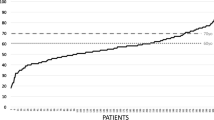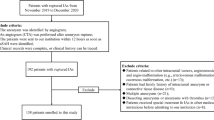Abstract
As the incidental diagnosis of unruptured intracranial aneurysms has been increasing, several scores were developed to predict risk of rupture and growth to guide the management choice. We retrospectively applied these scores to a multicenter series of patients with subarachnoid hemorrhage to test whether they would have predicted the risk of bleeding in the event of aneurysm discovery previous to its rupture. Demographical, clinical, and radiological information of 245 adults were retrieved from two neurovascular centers’ database. Data were pooled and PHASES, UCAS, and ELAPSS scores were retrospectively calculated for the whole population and their performances in identifying aneurysms at risk of rupture were compared. Mean PHASES, UCAS, and ELAPSS scores were 5.12 ± 3.08, 5.09 ± 2.62, and 15.88 ± 8.07, respectively. Around half (46%) of patients would have been assigned to the low- or very low-risk class (5-year rupture risk < 1%) in PHASES. Around 28% of patients would have been in a low-risk class, with a probability of 3-year rupture risk < 1% according to UCAS. Finally, ELAPSS score application showed a wider distribution among the risk classes, but a significant proportion of patients (45.5%) lie in the low- or intermediate-risk class for aneurysm growth. A high percentage of patients with ruptured aneurysms in this multicenter cohort would have been assigned to the lower risk categories for aneurysm growth and rupture with all the tested scores if they had been discovered before the rupture. Based on these observations, physicians should be careful about drawing therapeutic conclusions solely based on application of these scores.

Similar content being viewed by others
References
Backes D, Rinkel GJE, Greving JP, Velthuis BK, Murayama Y, Takao H, Ishibashi T, Igase M, terBrugge KG, Agid R, Jääskeläinen JE, Lindgren AE, Koivisto T, von und zu Fraunberg M, Matsubara S, Moroi J, Wong GKC, Abrigo JM, Igase K, Matsumoto K, Wermer MJH, van Walderveen MAA, Algra A, Vergouwen MDI (2017) ELAPSS score for prediction of risk of growth of unruptured intracranial aneurysms. Neurology 88:1600–1606. https://doi.org/10.1212/WNL.0000000000003865
Backes D, Vergouwen MDI, Tiel Groenestege AT, Bor ASE, Velthuis BK, Greving JP, Algra A, Wermer MJH, van Walderveen MAA, terBrugge KG, Agid R, Rinkel GJE (2015) PHASES score for prediction of intracranial aneurysm growth. Stroke 46:1221–1226. https://doi.org/10.1161/STROKEAHA.114.008198
Bijlenga P, Gondar R, Schilling S, Morel S, Hirsch S, Cuony J, Corniola M-V, Perren F, Rüfenacht D, Schaller K (2017) PHASES score for the management of intracranial aneurysm: a cross-sectional population-based retrospective study. Stroke 48:2105–2112. https://doi.org/10.1161/STROKEAHA.117.017391
Brinjikji W, Pereira VM, Khumtong R, Kostensky A, Tymianski M, Krings T, Radovanovich I (2018) PHASES and ELAPSS scores are associated with aneurysm growth: a study of 431 unruptured intracranial aneurysms. ssWorld Neurosurg 114:e425–e432. https://doi.org/10.1016/j.wneu.2018.03.003
Dolati P, Pittman D, Morrish WF, Wong J, Sutherland GR (2015) The frequency of subarachnoid hemorrhage from very small cerebral aneurysms (< 5 mm): a population-based study. Cureus. https://doi.org/10.7759/cureus.279
Etminan N, Brown RD, Beseoglu K, Juvela S, Raymond J, Morita A, Torner JC, Derdeyn CP, Raabe A, Mocco J, Korja M, Abdulazim A, Amin-Hanjani S, Al-Shahi Salman R, Barrow DL, Bederson J, Bonafe A, Dumont AS, Fiorella DJ, Gruber A, Hankey GJ, Hasan DM, Hoh BL, Jabbour P, Kasuya H, Kelly ME, Kirkpatrick PJ, Knuckey N, Koivisto T, Krings T, Lawton MT, Marotta TR, Mayer SA, Mee E, Pereira VM, Molyneux A, Morgan MK, Mori K, Murayama Y, Nagahiro S, Nakayama N, Niemelä M, Ogilvy CS, Pierot L, Rabinstein AA, Roos YBWEM, Rinne J, Rosenwasser RH, Ronkainen A, Schaller K, Seifert V, Solomon RA, Spears J, Steiger H-J, Vergouwen MDI, Wanke I, Wermer MJH, Wong GKC, Wong JH, Zipfel GJ, Connolly ES, Steinmetz H, Lanzino G, Pasqualin A, Rüfenacht D, Vajkoczy P, McDougall C, Hänggi D, LeRoux P, Rinkel GJE, Macdonald RL (2015) The unruptured intracranial aneurysm treatment score: a multidisciplinary consensus. Neurology 85:881–889. https://doi.org/10.1212/WNL.0000000000001891
Foreman PM, Hendrix P, Harrigan MR, Fisher WS, Vyas NA, Lipsky RH, Walters BC, Tubbs RS, Shoja MM, Griessenauer CJ (2018) PHASES score applied to a prospective cohort of aneurysmal subarachnoid hemorrhage patients. J Clin Neurosci 53:69–73. https://doi.org/10.1016/j.jocn.2018.04.014
Giordan E, Lanzino G, Rangel-Castilla L, Murad MH, Brinjikji W (2019) Risk of de novo aneurysm formation in patients with a prior diagnosis of ruptured or unruptured aneurysm: systematic review and meta-analysis. J Neurosurg 131:14–24. https://doi.org/10.3171/2018.1.JNS172450
Greving JP, Wermer MJH, Brown RD, Morita A, Juvela S, Yonekura M, Ishibashi T, Torner JC, Nakayama T, Rinkel GJE, Algra A (2014) Development of the PHASES score for prediction of risk of rupture of intracranial aneurysms: a pooled analysis of six prospective cohort studies. Lancet Neurol 13:59–66. https://doi.org/10.1016/S1474-4422(13)70263-1
Hilditch CA, Brinjikji W, Tsang AC, Nicholson P, Kostynskyy A, Tymianski M, Krings T, Radovanovic I, Pereira VM (2018) Application of PHASES and ELAPSS scores to ruptured cerebral aneurysms: how many would have been conservatively managed? J Neurosurg Sci. https://doi.org/10.23736/S0390-5616.18.04498-3
Hsu CC-T, Suthiphosuwan S, Huynh T, Murphy A, Li Y, Bharatha A (2019) High-resolution MRI vessel wall imaging in acute aneurysmal subarachnoid hemorrhage: spatiotemporal pattern and clinicoradiologic implications. Clin Neuroradiol. https://doi.org/10.1007/s00062-019-00843-8
van Kammen MS, Greving JP, Kuroda S, Kashiwazaki D, Morita A, Shiokawa Y, Kimura T, Cognard C, Januel AC, Lindgren A, Koivisto T, Jääskeläinen JE, Ronkainen A, Pyysalo L, Öhman J, Rahi M, Kuhmonen J, Rinne J, Leemans EL, Majoie CB, Vandertop WP, Verbaan D, Roos YBWEM, van den Berg R, Boogaarts HD, Moudrous W, van den Wijngaard IR, ten Hove L, Teo M, George EJS, Hackenberg KAM, Abdulazim A, Etminan N, Rinkel GJE, Vergouwen MDI (2019) External validation of the ELAPSS score for prediction of unruptured intracranial aneurysm growth risk. J Stroke 21:340–346. https://doi.org/10.5853/jos.2019.01277
Molyneux AJ, Kerr RSC, Yu L-M, Clarke M, Sneade M, Yarnold JA, Sandercock P (2005) International subarachnoid aneurysm trial (ISAT) of neurosurgical clipping versus endovascular coiling in 2143 patients with ruptured intracranial aneurysms: a randomised comparison of effects on survival, dependency, seizures, rebleeding, subgroups, and aneurysm occlusion. 366:9
Pagiola I, Mihalea C, Caroff J, Ikka L, Chalumeau V, Iacobucci M, Ozanne A, Gallas S, Marques M, Nalli D, Carrete H, Caldas JG, Frudit ME, Moret J, Spelle L (2019) The PHASES score: to treat or not to treat? Retrospective evaluation of the risk of rupture of intracranial aneurysms in patients with aneurysmal subarachnoid hemorrhage. J Neuroradiol:S0150986119302603. https://doi.org/10.1016/j.neurad.2019.06.003
Samuel N, Radovanovic I (2019) Genetic basis of intracranial aneurysm formation and rupture: clinical implications in the postgenomic era. Neurosurg Focus 47:E10. https://doi.org/10.3171/2019.4.FOCUS19204
Tominari S, Morita A, Ishibashi T, Yamazaki T, Takao H, Murayama Y, Sonobe M, Yonekura M, Saito N, Shiokawa Y, Date I, Tominaga T, Nozaki K, Houkin K, Miyamoto S, Kirino T, Hashi K, Nakayama T, for the Unruptured Cerebral Aneurysm Study Japan Investigators (2015) Prediction model for 3-year rupture risk of unruptured cerebral aneurysms in Japanese patients: cerebral aneurysm rupture risk. Ann Neurol 77:1050–1059. https://doi.org/10.1002/ana.24400
Von Elm E, Altman DG, Egger M, Pocock SJ, Gøtzsche PC, Vandenbroucke JP, Initiative STROBE (2007) Strengthening the Reporting of Observational Studies in Epidemiology (STROBE) statement: guidelines for reporting observational studies. BMJ 335:806–808. https://doi.org/10.1136/bmj.39335.541782.AD
Acknowledgments
We would like to thank all colleagues of the neurovascular teams of Fondazione Policlinico Universitario Agostino Gemelli IRCCS of Rome (Enrico Marchese, MD, PhD; Alessandro Olivi, MD; Alessandro Pedicelli, MD; Alfredo Puca, MD) and Santo Spirito Hospital of Pescara (Annunziato Mangiola, MD) who contributed to treating these patients with ruptured intracranial aneurysms.
Author information
Authors and Affiliations
Contributions
Conception and design: CLS, VS, LR, AA. Data collection: CLS, VS, LR, GT, IV, KL, SD, PB. Data analysis: CLS, VS, SD, GT, IV, AA. Helping with data analysis: PB, LR, KL. Drafting: CLS, LR, VS, AA. Helping with drafting: SD, GT, PB, IV, KL. Approval of final version: CLS, VS, FT, GT, IV, SD, KL, PB, AA
Corresponding author
Ethics declarations
Conflict of interest
The authors declare that they have no conflict of interest.
Ethical approval
Ethical approval was not needed for analysis of retrospective anonymous data.
Informed consent
All included patients gave their informed consent to the treatment of their personal data for scientific purposes at the time of treatment.
Additional information
Publisher’s note
Springer Nature remains neutral with regard to jurisdictional claims in published maps and institutional affiliations.
Electronic supplementary material
Supplementary Table 1
PHASES risk score (DOCX 14 kb)
Supplementary Table 2
UCAS-based risk score (DOCX 14 kb)
Supplementary Table 3
ELAPSS score for aneurysm growth (DOCX 15 kb)
Supplementary Table 4
Percentages of distribution of the patients’ characteristics (tot. 245) in the risk (DOCX 18 kb)
Rights and permissions
About this article
Cite this article
Sturiale, C.L., Stumpo, V., Ricciardi, L. et al. Retrospective application of risk scores to ruptured intracranial aneurysms: would they have predicted the risk of bleeding?. Neurosurg Rev 44, 1655–1663 (2021). https://doi.org/10.1007/s10143-020-01352-w
Received:
Revised:
Accepted:
Published:
Issue Date:
DOI: https://doi.org/10.1007/s10143-020-01352-w




